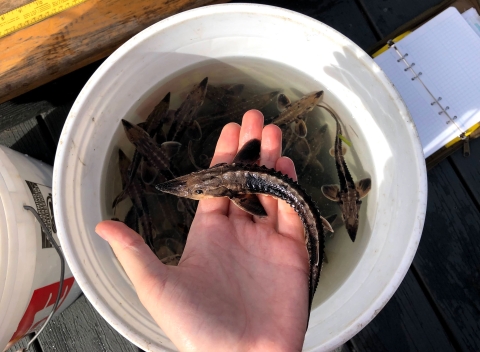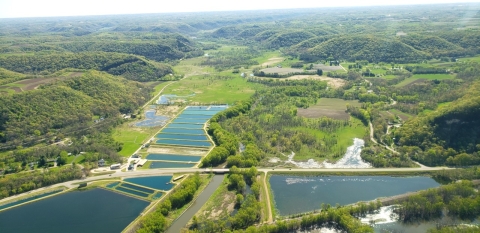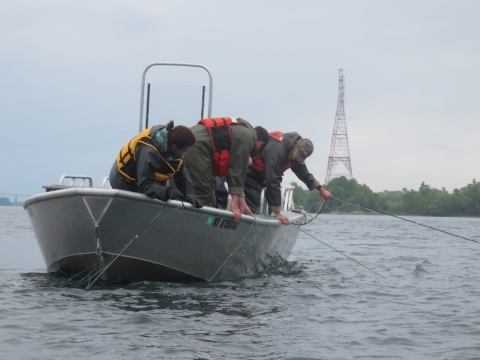On this chilly October morning, bucket after bucket is carried from a stocking truck parked on the bank. As they are carried by biologist and volunteer alike to the water’s edge, their contents can be seen tipped into the chilly waters: tiny lake sturgeon.
They seem out of time- small but armored, a fossil swimming around with its brothers and sisters in a bucket. These fingerlings have been raised either at Genoa National Fish Hatchery in Wisconsin or the Oneida Fish Culture Station in New York. They have made a long journey back to their native St. Lawrence River to join their relatives.
With luck, these individuals will grow into a strong generation of lake sturgeon. While they may not look it now, as adults they could weigh up to 300 pounds and be up to 7 feet long. They are the largest freshwater fish in New York waters. While they may look ferocious, their armor (called scutes) mostly protects them from predators when they are young and becomes less pronounced as the sturgeon grows. They have adapted to feed on insects, crustaceans and the occasional fish at the bottoms of lakes and rivers to grow to their massive size. Their presence in these waters highlights a momentous conservation push in New York.
What's going on?
One of the primary endeavors to conserve and restore lake sturgeon in New York is a stocking program. This truckload holds the next generation of individuals in a conservation effort that has spanned over 28 years. In this program, eggs are collected from live adults in the spring, safely driven to a hatchery and raised until fall, where they are released back into their native waters. This results in a much lower mortality rate of individuals. Lake sturgeon may seem hardy, but they have been greatly affected by human impact through overharvesting and habitat degradation. While previously prevalent in the Great Lakes and its tributaries, their decline eventually led them to be listed as Endangered or Threatened by many states. As of 1983, lake sturgeon were listed as Threatened in New York.
Now, the protocol for the stocking of these fish has been expertly crafted through multi-agency partnerships and many studies trying to understand the most successful way to raise and stock lake sturgeon. Every year this process begins anew.
Egg take - Late May/ Early June
In the Spring, eggs are collected and fertilized by the New York State Department of Environmental Conservation (NYSDEC) and the U.S. Fish and Wildlife Service (FWS) from adult lake sturgeon caught in the St. Lawrence River below the Moses-Saunders Power Dam. The New York Power Authority (NYPA) provides site access and logistical support. Following the egg collection, the sturgeon are then released back into the St. Lawrence River.
Taken to Genoa National Fish Hatchery and Oneida Fish Culture Station
The now fertilized eggs are carefully driven to either Genoa National Fish Hatchery in Wisconsin or the Oneida Fish Culture Station in New York.
Raised by our partners - June - October
For four months, the young sturgeon are raised safely at the hatchery and culture station until they develop into seven-inch-long sturgeon fingerlings.
Driven back to New York - October
In early October the fingerlings have grown large enough to be driven back to their native St. Lawrence River. They are released into New York waters of the St. Lawrence River and other waters in the St. Lawrence River watershed, where they will continue to grow and develop.
How was this protocol created?
This process is the product of many individuals’ entire careers. In 1993, the first efforts to restore lake sturgeon were championed by the NYSDEC. Partners continued to be added and in 2018, multiple organizations created a collaborative recovery plan. These organizations include the NYSDEC, FWS, NYPA, St. Regis Mohawk Tribe, United States Geological Survey, and Cornell University. This recovery plan dictates the current recovery efforts and conservation goals for lake sturgeon throughout New York State. Jana Lantry, Fisheries Manager at the NYSDEC, speaks on this partnership:
“Lake sturgeon stocking in the St. Lawrence River is a collaborative partnership between NYSDEC, FWS, NYPA with each agency playing critical roles...The collective ‘team’ has contributed to several years of successful stocking that led to the recent NYSDEC announcement that the lake sturgeon population in the St. Lawrence River has exceeded crucial metrics outlined in the lake sturgeon Recovery Plan.”
As a key member of the partnership, the NYSDEC continues to contribute to both the stocking and other facets of lake sturgeon conservation which help give a broader understanding of the fish. Each year, they collect biological information from individuals in the St. Lawrence River, which helps decision making for lake sturgeon conservation both annually and long-term.
In partnership with the NYSDEC, the FWS’ New York Field Office (NYFO) has participated in lake sturgeon conservation since 2006. Participation was made possible by the creation of the Fish Enhancement, Mitigation, and Research Fund (FEMRF) in 2004. This fund was created during the relicensing of the New York Power Authority’s operation of the Moses-Saunders Power Dam. Through the FEMRF, the FWS’ Genoa National Fish Hatchery is funded for the rearing and tagging of sturgeon fingerlings, as well as annual technical support during the egg collection process along the St. Lawrence River. This funding provided by NYPA to the FWS is a vital component to the overall conservation of lake sturgeon in the St. Lawrence River.
Scott Schlueter, Biologist with the NYFO and FEMRF Project Manager, has been involved in lake sturgeon conservation in New York since the beginning. He collected the first broodstock broodstock
The reproductively mature adults in a population that breed (or spawn) and produce more individuals (offspring or progeny).
Learn more about broodstock and was present at the very first lake sturgeon egg collection in New York and has been a part of it most years since.
"Sturgeon have been around for almost 200 million years based on the fossil record, and within roughly 1 human generation, we almost wiped them from the globe...the sturgeon egg collection and stocking effort is very important," Scott observes.
As much as field experts are needed in the St. Lawrence area for collection of fish eggs, so are experts needed to raise the eggs into fingerlings.
Doug Aloisi, Field Supervisor at the Genoa National Fish Hatchery, has been a part of lake sturgeon conservation in one way or another since 1993, so when the NYSDEC and NYFO approached him in 2012, he and his organization had experience to offer. The reason he enjoys this work and has continued to be involved in sturgeon restoration over his career is clear.
"I really think this is a legacy fish- something we can invest in today that will long outlast our efforts...the fish we stock today have the potential to live 150 years."
Doug leads the raising of lake sturgeon eggs at the Genoa National Fish Hatchery until they are large enough to survive in the St. Lawrence River for the rest of their long lives. The Genoa National Fish Hatchery is funded for this project by NYPA through the FEMRF. Recently, Ontario Power Generation, the Canadian counterparts to NYPA, have provided additional funding to the Genoa National Fish Hatchery to stock thousands additional fingerlings a year, furthering the stocking efforts and its contributions to the St. Lawrence River.
While the rewards are vast, the long life of a lake sturgeon brings other challenges. Female lake sturgeon are not sexually mature until about 20 years old, which means stocking efforts need to continue for at least that long to ensure a viable breeding population. In order to also address concerns of genetic diversity, stocking should continue even longer than that to make sure there is a large enough genetic pool. This means it is recommended for consistent and viable stocking to continue for at least 25 years.
These conservation parameters are why long-term partnership is key, and why this work can take the majority of a biologist’s career.
Why help these fish?
Lake sturgeon are an important puzzle piece of the ecosystem they reside in. They have been called a 'barometer of health' for the whole of the Great Lakes ecosystem, as they require a clean water in order to spawn and live. They feed on aquatic invertebrates that are sensitive to change. Because they live long, not only can they give a greater understanding of health of an ecosystem, but they can also offer vast return on our investment.
Their decline has primarily been caused by human impacts. Their commercial value was realized in the late 1800's, and for 50 years, they were heavily harvested. Likewise, historic spawning grounds where their populations could replenish were blocked off by dams constructed on waterways, or destroyed through siltation caused by deforestation, poor agricultural practices, and dredging.
With this legacy in mind, NYPA has stepped in to aid the conservation effort of lake sturgeon even past the funding they provide. Jeff Gerlach, Director of Environmental Operations at NYPA, has been working with the NYFO and NYSDEC for many years to provide what his organization can towards the recovery of this species. Yearly they provide resources, site access, and logistical support for the egg take and stocking, but they also have funded many studies to better understand the species.
"It's all part of our commitment to bring the species back," Gerlach says, "It's important to the Power Authority; it's our obligation to provide resources and effort to reestablish and learn about this fish."
Scott Schlueter says, "The joint sturgeon recovery planning and implementation is a model for partnership in achieving shared species recovery and restoration goals. Together we can advance our goals for the species more than one agency can on its own."
The future of the St. Lawrence Giant
This extensive conservation partnership has begun to prove successful - as of 2022, population numbers have increased to the point of hitting recovery goals in over half of the management areas identified when the program began. These benchmarks highlight the importance of partnerships and the role they play in conservation initiatives. The unique life history of sturgeon gives way to a complex approach to their restoration. Our impacts to their environment and the role we have played in lake sturgeon decline allow us the opportunity to form these partnerships and to continue to contribute to their recovery.
Together, this state, federal, and international effort will continue to move towards the restoration of such an important and unique species in the St. Lawrence River watershed: to once again witness these gentle giants thriving in their native ecosystem.
For more video content: Lake sturgeon Stocking Program, YouTube
To learn more about lake sturgeon: USFWS species page







